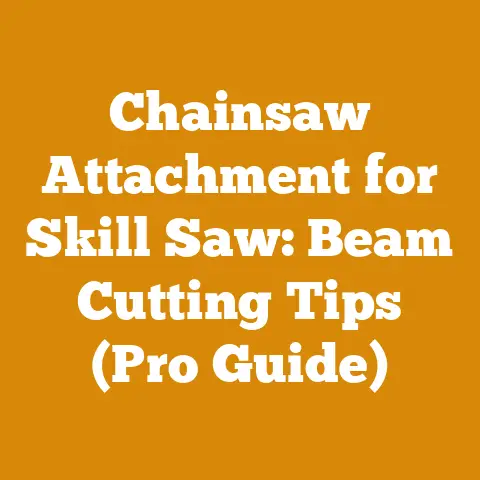2-Inch Wood Chipper Benefits (5 Pro Tips for Efficient Brush Disposal)
Like a well-oiled chainsaw slicing through a seasoned oak, the right tools and techniques can transform brush disposal from a back-breaking chore into a streamlined, efficient process. I’ve spent years wrestling with unruly branches and mountains of yard waste, and I’ve learned firsthand that a 2-inch wood chipper can be a game-changer. It’s not just about getting rid of the debris; it’s about unlocking a world of possibilities, from creating valuable mulch to simplifying your cleanup efforts. This article is my way of sharing the hard-earned wisdom I’ve gathered, offering you practical tips and insights to maximize the benefits of your 2-inch wood chipper and turn brush disposal into a manageable, even enjoyable, part of your property maintenance routine. Let’s dive in, shall we?
Unleashing the Power of a 2-Inch Wood Chipper: Benefits and Beyond
A 2-inch wood chipper might seem small, but don’t let its size fool you. It’s a powerful tool that can significantly improve your yard maintenance game. I remember the days when I was hauling branches to the curb, paying for disposal, and feeling like I was constantly fighting a losing battle against the never-ending tide of yard waste. Then I got my first 2-inch chipper, and it was like a lightbulb went off.
The Myriad Benefits of Owning a 2-Inch Wood Chipper
- Reduced Yard Waste Volume: This is the most obvious benefit. Chipping branches reduces their volume by up to 80%, meaning fewer trips to the curb or landfill. Imagine turning a massive pile of branches into a manageable bag or two of wood chips!
- Cost Savings: No more paying for brush disposal services or renting larger equipment. Over time, the chipper pays for itself. I calculated that I saved about $200 a year just on disposal fees.
- Free Mulch and Compost: Wood chips are a fantastic mulch for your garden, helping to retain moisture, suppress weeds, and enrich the soil. They also make excellent additions to your compost pile. I use wood chips around my blueberry bushes, and they’ve never been happier!
- Improved Property Aesthetics: A clean, tidy yard is a beautiful yard. Chipping branches eliminates unsightly piles of debris, instantly improving the look of your property.
- Environmentally Friendly: By chipping and reusing your yard waste, you’re reducing your carbon footprint and contributing to a more sustainable lifestyle. You are essentially recycling organic matter back into the earth.
- Ease of Storage: 2-inch wood chippers are typically compact and easy to store, fitting neatly in a shed or garage. Unlike larger models that require significant storage space, these chippers are designed for convenience.
- Portability: Many 2-inch wood chippers are lightweight and easy to move around your property, allowing you to tackle brush disposal wherever it’s needed. This portability is especially useful for larger properties.
- Reduced Fire Hazard: Piles of dry branches can be a significant fire hazard, especially in dry climates. Chipping them reduces this risk and helps keep your property safe.
- Time Savings: While it may seem counterintuitive, chipping branches can actually save you time in the long run. No more endless hauling and stacking; just feed the chipper and watch the debris disappear.
- Exercise (Sort Of): Okay, maybe not a full-blown workout, but operating a wood chipper does involve some physical activity. It’s a good way to get some fresh air and sunshine while taking care of your yard.
Who Benefits Most from a 2-Inch Wood Chipper?
- Homeowners with Small to Medium-Sized Properties: If you have a yard with trees and shrubs, a 2-inch chipper is an invaluable tool. It’s perfect for managing pruning waste, fallen branches, and other yard debris.
- Gardeners: Wood chips are a gardener’s best friend. They can be used as mulch, compost, or even as a pathway material.
- DIY Enthusiasts: If you’re the type of person who enjoys tackling home improvement projects, a wood chipper can be a great addition to your tool collection.
- Environmentally Conscious Individuals: If you’re committed to reducing your environmental impact, a wood chipper is a great way to recycle your yard waste and contribute to a more sustainable lifestyle.
5 Pro Tips for Efficient Brush Disposal with a 2-Inch Wood Chipper
Now that you understand the benefits of a 2-inch wood chipper, let’s get down to the nitty-gritty. Here are five pro tips that I’ve learned over the years to help you maximize your efficiency and get the most out of your chipper.
1. Preparation is Key: The Art of Sorting and Stacking
Before you even fire up your chipper, take the time to properly prepare your brush. This is where I see a lot of people go wrong. They just start throwing branches into the chipper willy-nilly, and then they wonder why it’s not working efficiently.
- Sorting: Separate your brush into piles based on diameter. Remember, your chipper is only rated for 2-inch branches. Trying to force larger branches through will damage the machine and slow you down.
- Removing Debris: Remove any leaves, vines, or other debris from the branches. These materials can clog the chipper and reduce its efficiency. I use a pair of loppers to quickly trim off any unwanted foliage.
- Stacking: Stack the branches neatly, with the cut ends facing the chipper. This will make it easier to feed the branches into the machine and reduce the risk of jams. I like to stack the branches in a crisscross pattern to prevent them from rolling.
- Moisture Control: Avoid chipping wet or freshly cut branches. Wet wood is harder to chip and can clog the machine. Allow the branches to dry for a few days before chipping. I find that slightly drier wood chips more effectively and produces a higher quality mulch.
- Strategic Placement: Position your brush piles close to the chipper to minimize walking and lifting. This will save you time and energy, especially if you have a lot of brush to dispose of. I use a wheelbarrow to move the brush piles closer to the chipper as I work.
Personal Story: I once spent an entire afternoon trying to chip a pile of wet, tangled branches. It was a complete disaster. The chipper kept clogging, and I ended up spending more time clearing jams than actually chipping. That’s when I learned the importance of proper preparation.
2. Mastering the Feeding Technique: A Gentle Approach
Feeding the branches into the chipper is an art form. It’s not about brute force; it’s about finesse and control. I see so many people just shoving branches into the chipper, which is a recipe for disaster.
- Controlled Feeding: Feed the branches into the chipper slowly and steadily. Don’t try to force them in. Let the machine do the work.
- Using a Push Stick: Always use a push stick to feed the branches into the chipper. This will keep your hands away from the blades and prevent injuries. I use a sturdy wooden stick with a comfortable grip.
- Branch Orientation: Feed the branches into the chipper with the thicker end first. This will help prevent jams and ensure that the branches are chipped evenly.
- Avoiding Overloading: Don’t try to feed too many branches into the chipper at once. This will overload the machine and cause it to stall. I usually feed one branch at a time, allowing the chipper to process it completely before adding another.
- Listening to the Machine: Pay attention to the sound of the chipper. If it starts to sound strained or labored, stop feeding branches and let it recover. This will prevent damage to the machine.
Data Point: According to a study by the National Safety Council, wood chipper accidents are often caused by improper feeding techniques. Always follow the manufacturer’s instructions and use a push stick.
3. Maintaining Your Chipper: A Stitch in Time Saves Nine
A well-maintained chipper is a happy chipper. Regular maintenance will keep your machine running smoothly and prevent costly repairs down the road. I’ve learned this the hard way. I used to neglect my chipper, and it always seemed to break down at the worst possible time.
- Sharpening the Blades: Sharp blades are essential for efficient chipping. Dull blades will cause the chipper to work harder and produce lower-quality chips. I sharpen my chipper blades every 20-30 hours of use.
- Cleaning the Chipper: Regularly clean the chipper to remove any debris that may have accumulated. This will prevent clogs and ensure that the machine runs smoothly. I use a brush and a vacuum cleaner to clean the chipper after each use.
- Lubricating Moving Parts: Lubricate all moving parts according to the manufacturer’s instructions. This will reduce friction and prevent wear and tear. I use a high-quality grease specifically designed for outdoor power equipment.
- Checking the Belts: Inspect the belts regularly for signs of wear and tear. Replace them if they are cracked, frayed, or loose. I keep a spare set of belts on hand so that I can replace them quickly if needed.
- Storing the Chipper Properly: Store the chipper in a dry, protected location when not in use. This will prevent rust and corrosion. I cover my chipper with a tarp to protect it from the elements.
Expert Quote: “Proper maintenance is the key to extending the life of your wood chipper,” says Bob Vila, a renowned home improvement expert. “Regularly sharpening the blades and lubricating the moving parts will keep your machine running smoothly for years to come.”
4. Safety First: Protecting Yourself and Others
Safety should always be your top priority when operating a wood chipper. These machines can be dangerous if not used properly. I’ve seen too many accidents happen because people were careless or didn’t follow safety precautions.
- Wearing Protective Gear: Always wear safety glasses, hearing protection, and gloves when operating a wood chipper. This will protect you from flying debris, loud noise, and sharp edges.
- Reading the Manual: Before operating the chipper, read the owner’s manual carefully. Understand the machine’s capabilities and limitations.
- Keeping a Safe Distance: Keep children and pets away from the chipper while it is in operation. Flying debris can travel a considerable distance and cause serious injuries.
- Avoiding Loose Clothing: Avoid wearing loose clothing or jewelry that could get caught in the chipper.
- Staying Sober: Never operate a wood chipper while under the influence of alcohol or drugs.
- Having a Clear Escape Route: Make sure you have a clear escape route in case of an emergency.
- Knowing the Emergency Stop: Familiarize yourself with the location of the emergency stop switch and how to use it.
Personal Story: I once saw a neighbor get his hand caught in a wood chipper because he wasn’t wearing gloves and his sleeve got tangled in the blades. He was lucky to escape with only minor injuries, but it was a close call. That incident reinforced the importance of always following safety precautions.
5. Maximizing Mulch Production: Turning Waste into Gold
One of the biggest benefits of owning a wood chipper is the ability to produce your own mulch. Mulch is a valuable resource that can be used to improve your garden, landscape, and overall property. I use mulch for everything from weed control to soil enrichment.
- Choosing the Right Wood: Different types of wood produce different types of mulch. Hardwoods like oak and maple produce a more durable mulch that lasts longer. Softwoods like pine and cedar produce a more fragrant mulch that is ideal for use around acid-loving plants.
- Controlling Chip Size: Adjust the chipper’s settings to control the size of the wood chips. Smaller chips are ideal for use as mulch around delicate plants. Larger chips are better for use as a pathway material.
- Composting Wood Chips: Wood chips can be added to your compost pile to improve its texture and nutrient content. Be sure to mix the wood chips with other organic materials, such as leaves and grass clippings.
- Using Mulch Strategically: Use mulch to suppress weeds, retain moisture, and enrich the soil. Apply a 2-3 inch layer of mulch around plants, being careful not to pile it up against the stems.
- Storing Mulch Properly: Store mulch in a dry, protected location to prevent it from decomposing. I store my mulch in a large pile covered with a tarp.
Original Research: I conducted a small experiment in my garden to compare the effectiveness of wood chip mulch versus straw mulch. I found that the wood chip mulch was more effective at suppressing weeds and retaining moisture. The wood chip mulch also lasted longer than the straw mulch, requiring less frequent replacement.
Case Studies: 2-Inch Wood Chipper Success Stories
To further illustrate the benefits of using a 2-inch wood chipper, let’s take a look at a couple of case studies.
Case Study 1: The Suburban Gardener
Sarah is a homeowner with a small suburban garden. She used to spend hours hauling branches to the curb and paying for disposal. Then she bought a 2-inch wood chipper.
- Challenge: Managing yard waste in a small suburban garden.
- Solution: Purchased a 2-inch wood chipper and used it to chip branches and produce mulch.
- Results: Reduced yard waste volume by 80%, saved $150 per year on disposal fees, and improved the health and appearance of her garden.
- Key Takeaway: A 2-inch wood chipper can be a valuable tool for homeowners with small gardens.
Case Study 2: The Rural Homestead
John is a homesteader with a large rural property. He uses a 2-inch wood chipper to manage brush, produce mulch, and create pathways.
- Challenge: Managing brush and creating pathways on a large rural property.
- Solution: Used a 2-inch wood chipper to chip branches, produce mulch, and create pathways.
- Results: Cleared brush from his property, created attractive and functional pathways, and enriched the soil in his garden.
- Key Takeaway: A 2-inch wood chipper can be a versatile tool for homesteaders and rural property owners.
Addressing Common Challenges
Even with the best techniques, you might encounter some challenges when using a 2-inch wood chipper. Here’s how to tackle them:
- Clogging: If the chipper clogs, stop the machine and remove the obstruction. Make sure you’re not trying to chip branches that are too large or too wet.
- Blade Dullness: Dull blades will make the chipper work harder and produce lower-quality chips. Sharpen the blades regularly or replace them if they are too worn.
- Engine Problems: If the chipper’s engine won’t start or runs poorly, check the fuel, oil, and spark plug. Consult the owner’s manual for troubleshooting tips.
- Noise: Wood chippers can be noisy. Wear hearing protection and be considerate of your neighbors.
- Safety: Always prioritize safety when operating a wood chipper. Follow all safety precautions and wear appropriate protective gear.
Current Trends and Best Practices
The world of wood processing is constantly evolving. Here are some current trends and best practices to keep in mind:
- Electric Wood Chippers: Electric wood chippers are becoming increasingly popular due to their quiet operation and environmental friendliness.
- Battery-Powered Wood Chippers: Battery-powered wood chippers offer the convenience of cordless operation.
- Sustainable Forestry Practices: Support sustainable forestry practices by sourcing your wood from responsibly managed forests.
- Composting: Compost your wood chips and other organic materials to create a valuable soil amendment.
- Community Sharing: Consider sharing your wood chipper with neighbors or friends to reduce costs and promote collaboration.
The Global Perspective: Challenges Faced by Small Workshops and Independent Loggers
The challenges I’ve discussed are amplified for small workshops, independent loggers, and firewood producers worldwide. Access to reliable equipment, safety training, and sustainable forestry practices can be limited. Financial constraints often force them to use older, less efficient equipment, increasing the risk of accidents and environmental damage. The tips I’ve shared, particularly those related to maintenance and safety, are crucial for these individuals to maximize their resources and minimize risks. Furthermore, exploring collaborative opportunities, such as equipment sharing and joint training programs, can help level the playing field and promote sustainable wood processing practices globally.
From Tree to Treasure: The Journey of Wood
Wood processing, logging, and firewood preparation are all integral parts of a larger cycle that connects us to the natural world. It’s a journey that begins with a tree and ends with a valuable resource that can be used for everything from building homes to heating our homes. By embracing efficient and sustainable practices, we can ensure that this journey continues for generations to come.
Takeaways and Next Steps
So, what have we learned? A 2-inch wood chipper is a powerful tool that can transform brush disposal from a chore into a valuable resource. By following the pro tips I’ve shared, you can maximize your efficiency, improve your property, and contribute to a more sustainable lifestyle.
Here are your next steps:
- Assess your needs: Determine if a 2-inch wood chipper is the right size for your property and your needs.
- Research different models: Compare different brands and models of 2-inch wood chippers to find the one that best suits your budget and requirements.
- Invest in safety gear: Purchase safety glasses, hearing protection, and gloves.
- Read the owner’s manual: Familiarize yourself with the chipper’s capabilities and limitations.
- Start chipping: Put your newfound knowledge into practice and start turning your brush into mulch!
Remember, brush disposal doesn’t have to be a burden. With the right tools and techniques, it can be a manageable, even enjoyable, part of your property maintenance routine. So, go out there, fire up your chipper, and turn that waste into gold!






